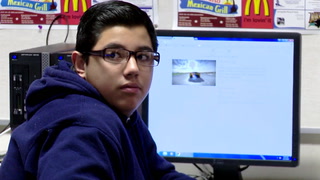Series Coding in the Classroom : Coding in the Algebra Classroom
Math.Practice.MP1
| Common core State Standards
- Math: Math
- Practice: Mathematical Practice Standards
-
MP1: Make sense of problems and persevere in solving them.
Mathematically proficient students start by explaining to themselves the meaning of a problem and looking for entry points to its solution. They analyze givens, constraints, relationships, and goals. They make conjectures about the form and meaning of the solution and plan a solution pathway rather than simply jumping into a solution attempt. They consider analogous problems, and try special cases and simpler forms of the original problem in order to gain insight into its solution. They monitor and evaluate their progress and change course if necessary. Older students might, depending on the context of the problem, transform algebraic expressions or change the viewing window on their graphing calculator to get the information they need. Mathematically proficient students can explain correspondences between equations, verbal descriptions, tables, and graphs or draw diagrams of important features and relationships, graph data, and search for regularity or trends. Younger students might rely on using concrete objects or pictures to help conceptualize and solve a problem. Mathematically proficient students check their answers to problems using a different method, and they continually ask themselves, \"Does this make sense?\" They can understand the approaches of others to solving complex problems and identify correspondences between different approaches.
Math.Practice.MP4
Common core State Standards
- Math: Math
- Practice: Mathematical Practice Standards
-
MP4: Model with mathematics.
Mathematically proficient students can apply the mathematics they know to solve problems arising in everyday life, society, and the workplace. In early grades, this might be as simple as writing an addition equation to describe a situation. In middle grades, a student might apply proportional reasoning to plan a school event or analyze a problem in the community. By high school, a student might use geometry to solve a design problem or use a function to describe how one quantity of interest depends on another. Mathematically proficient students who can apply what they know are comfortable making assumptions and approximations to simplify a complicated situation, realizing that these may need revision later. They are able to identify important quantities in a practical situation and map their relationships using such tools as diagrams, two-way tables, graphs, flowcharts and formulas. They can analyze those relationships mathematically to draw conclusions. They routinely interpret their mathematical results in the context of the situation and reflect on whether the results make sense, possibly improving the model if it has not served its purpose.
Save to My Resources
PLEASE CREATE A NEW ACCOUNT OR LOG IN TO ACCESS THIS CONTENT
Enjoy your first video for free. Subscribe for unlimited access.
Have questions about subscribing?
Click Here to learn more about individual subscriptions.
Click Here to learn more about School and Institution access.
Discussion and Supporting Materials
Thought starters
- Why does Mr. Kwon believe it is important to integrate technology into his algebra support classes?
- How does coding help students deepen their understanding of algebra?
- How does Mr. Kwon formatively assess his students?
In Partnership With:

School Details
Mariner High School200 120th Street Southwest
Everett WA 98204
Population: 2334
Data Provided By:

Teachers
Joshua Kwon
Math / 9 10 11 12 / Teacher
Newest
|
4 MIN
|
5 MIN
|
5 MIN
UNCUT CLASSROOMS
| TCHERS' VOICE
English Language Arts












12 Comments
Christopher Sch... Jan 16, 2023 10:43am
Desmos Activities are amazing! I appreciate how the teacher used the Desmos Activities to help students use mathematics to model the rockets speed and to persevere through the activity. Desmos Activities are like a mathematical playground for kids to experiment and make conncections. I like what the teacher said about seeing the connections between the equation, table, and graph.
Rachel D'Mello Aug 12, 2021 5:39am
Very interesting and effective strategy to help students understand and apply math concepts and enjoy learning.
Cade Patterson Aug 24, 2019 9:03pm
This is a great way to teach algebra to students in a new way besides a pencil and graph paper. This would be a fun lesson to teach as well as learn more about. This is a great series!
Hilda Arocha Apr 16, 2018 10:33am
Pranav Vishnu Sep 5, 2017 11:26am